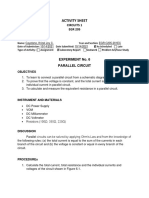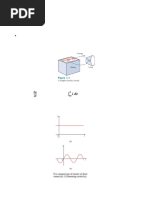Lab3 G5
Uploaded by
fatimabest15Lab3 G5
Uploaded by
fatimabest15Department of Electrical Engineering
Circuits 1 Lab
Experiment # 3
VDR and CDR (Part 2)
_______________ :Section: Day/Time
:Name & ID Number
____________________________________________.1
____________________________________________.2
__________________________________________ :Professor
______________________________________ :Lab Engineer
Circuit Analysis I Lab Manual 1
0402203 Circuit Analysis I Laboratory Experiment # 3
VDR and CDR (PART-2)
OBJECTIVES
To learn how to identify and combine resistors in series and parallel.
To learn the application of voltage division rule (VDR) and current division rule (CDR).
To learn the use of software simulation tool-CADENCE-SPICE.
THEORY
If a node contains two elements only, we can say that these two elements are
connected in series. While a parallel combination occurs when elements share the
same pair of nodes.
Voltage divider rule is applicable for two series resistors only and for the given
polarities, as show below (Figure 1):
Figure 1
Current divider rule is applicable for two parallel resistors only and for the given
current directions, as show below (Figure 2):
Figure 2
If there is any change in the voltage polarities or the current directions, VDR or CDR must be changed
accordingly.
PRE-LAB
Consider the circuit shown in Figure 3:
R1
1.2 KΩ
R3 330 Ω
780 Ω
(use two resistors of 390 Ω
R4 in series)
R5 270 Ω
Circuit Analysis I Lab Manual 2
Figure 3
1. Make R2 open circuit, then:
a) Identify all the series and parallel elements. Put your answers in Table- 1.
Table 1: R2 is open circuit
Series Elements Parallel Elements
2. Make R2 shorted then identify the series and parallel elements in the circuits. Put
you answers in Table-2.
Table 2: R2 is short circuit
Series Elements Parallel Elements
PROCEDURE
Assemble the circuit shown in Figure-3 on the breadboard
1. Make R2 open circuit, find all the voltages (V1, V2, V3, V4, V5) Put your answers in Table 3.
2. Use multimeter to measure all the currents (IS, I1, I2, I3, I4, I5). Your answer must follow the given
polarity of voltages and currents. Wrong polarity is considered wrong. Put your answers in Table 3.
3. Make R2 short circuit, measure all the voltages (V1, V2, V3, V4, V5) Put your answers in Table 4.
4. Measure all the currents (IS, I1, I2, I3, I4, I5). Put your answers in Table 4.
Table 3: R2 is open circuit
V1 V2 V3 V4 V5 IS I1 I2 I3 I4 I5
Measured
Value
Table 4: R2 is short circuit
V1 V2 V3 V4 V5 IS I1 I2 I3 I4 I5
Measured
Value
REPORT AND RESULTS
1. What do you think will happen to the element voltages and currents in the condition when R2 is
shorted? Will it change? Explain your answer.
Circuit Analysis I Lab Manual 3
_______________________________________________________________________________
When R2 is shorted, the voltage across it becomes zero, and the current through that
_______________________________________________________________________________
branch increases significantly. As a result, the currents and voltages in the rest of the
_______________________________________________________________________________
circuit will decrease because the short circuit diverts most of the current through the
_______________________________________________________________________________
zero-resistance path.
CONCLUSION/ DISCUSSION: (use extra paper if necessary)
_____________________________________________________________________________________
In this lab, we applied the Voltage division Rule (VDR) and Current division Rule (CDR) to analyze
_____________________________________________________________________________________
circuits with resistors in series and parallel. Shorting R2 drastically changed the circuit behavior,
_____________________________________________________________________________________
causing the voltage across R2 to become zero and increasing the current through that branch. The
_____________________________________________________________________________________
experiment demonstrated how changes in circuit configuration affect voltage and current distribution,
_____________________________________________________________________________________
consistent with theoretical expectations.
Circuit Analysis I Lab Manual 4
You might also like
- Faculty of Electrical Engineering Universiti Teknologi MaraNo ratings yetFaculty of Electrical Engineering Universiti Teknologi Mara9 pages
- Experiment 5 Series & Parallel Circuits Voltage Divider & Current Divider RulesNo ratings yetExperiment 5 Series & Parallel Circuits Voltage Divider & Current Divider Rules5 pages
- Experiment 4 Series & Parallel Circuits Voltage Divider & Current Divider RulesNo ratings yetExperiment 4 Series & Parallel Circuits Voltage Divider & Current Divider Rules7 pages
- Electronic Circuit Style CV by SlidesgoNo ratings yetElectronic Circuit Style CV by Slidesgo32 pages
- Faculty of Electrical Engineering Universiti Teknologi MaraNo ratings yetFaculty of Electrical Engineering Universiti Teknologi Mara9 pages
- Experiment 4: To Verify Current Divider Rule and Voltage Divider RuleNo ratings yetExperiment 4: To Verify Current Divider Rule and Voltage Divider Rule7 pages
- Laboratory Manual Electrical Circuits INo ratings yetLaboratory Manual Electrical Circuits I29 pages
- Labs For Verification of Ohms Law Series and Parallel CircuitsNo ratings yetLabs For Verification of Ohms Law Series and Parallel Circuits9 pages
- DC Lab - Exp - 2 - Student - Manual (Spring 22-23)No ratings yetDC Lab - Exp - 2 - Student - Manual (Spring 22-23)5 pages
- Voltage Divider Rule and Current Divider RuleNo ratings yetVoltage Divider Rule and Current Divider Rule6 pages
- Eee1001-Electric Circuits and Systems Lab AssesmentNo ratings yetEee1001-Electric Circuits and Systems Lab Assesment19 pages
- FUNDAMENTALS IN THE ELECTRIC CIRCUITS MATERIALNo ratings yetFUNDAMENTALS IN THE ELECTRIC CIRCUITS MATERIAL17 pages
- Activity No. 2: Voltage Divider and Current Divider Circuit DesignNo ratings yetActivity No. 2: Voltage Divider and Current Divider Circuit Design5 pages
- LAB 1 Ohm's Law, Series and Parallel CircuitNo ratings yetLAB 1 Ohm's Law, Series and Parallel Circuit6 pages
- DC Lab Exp 2 Student Manual (Fall 22-23)No ratings yetDC Lab Exp 2 Student Manual (Fall 22-23)6 pages
- Chapter-2 Electrical Circuit ParametersNo ratings yetChapter-2 Electrical Circuit Parameters40 pages
- Pneumatic Tension Control System MCS-166/MCS-207/MCS-208: Installation & Operating InstructionsNo ratings yetPneumatic Tension Control System MCS-166/MCS-207/MCS-208: Installation & Operating Instructions26 pages
- Youess Solar System (2024-04-25 01 - 44 - 55)No ratings yetYouess Solar System (2024-04-25 01 - 44 - 55)26 pages
- NCP1606 Cost Effective Power Factor Controller: Marking DiagramsNo ratings yetNCP1606 Cost Effective Power Factor Controller: Marking Diagrams22 pages
- Dressler ARA-2000 Active Antenna - What's Inside ?No ratings yetDressler ARA-2000 Active Antenna - What's Inside ?7 pages
- 1MRK506371-UUS - en - J - Commissioning Manual, Line Distance Protection REL670 Version 2.2 ANSINo ratings yet1MRK506371-UUS - en - J - Commissioning Manual, Line Distance Protection REL670 Version 2.2 ANSI290 pages
- Calibration Procedure For Melting Point Apparatus: IA 9100, 9200 and 9300No ratings yetCalibration Procedure For Melting Point Apparatus: IA 9100, 9200 and 93002 pages
- Raypa ID Culture Incubator - User ManualNo ratings yetRaypa ID Culture Incubator - User Manual13 pages
- HD74LS76A: Dual J-K Flip-Flops (With Preset and Clear)No ratings yetHD74LS76A: Dual J-K Flip-Flops (With Preset and Clear)7 pages
- Lecture 05 Control Theory - System AnalysisNo ratings yetLecture 05 Control Theory - System Analysis20 pages
- Adaptive Distance Protection Compensated: Transmission LinesNo ratings yetAdaptive Distance Protection Compensated: Transmission Lines6 pages
- Electronic Gas Volume Corrector Basics and Installation ExamplesNo ratings yetElectronic Gas Volume Corrector Basics and Installation Examples19 pages
- Instruction Manual: Undervoltage, Overvoltage, Under/Overvoltage Relays BE1-27, BE1-59, BE1-27/59No ratings yetInstruction Manual: Undervoltage, Overvoltage, Under/Overvoltage Relays BE1-27, BE1-59, BE1-27/5950 pages
- 60-PREP-0005 Kornit Electrical Modular Curing System Site Preparation GuideNo ratings yet60-PREP-0005 Kornit Electrical Modular Curing System Site Preparation Guide20 pages
- A Guide to Electronic Maintenance and RepairsFrom EverandA Guide to Electronic Maintenance and Repairs
- Faculty of Electrical Engineering Universiti Teknologi MaraFaculty of Electrical Engineering Universiti Teknologi Mara
- Experiment 5 Series & Parallel Circuits Voltage Divider & Current Divider RulesExperiment 5 Series & Parallel Circuits Voltage Divider & Current Divider Rules
- Experiment 4 Series & Parallel Circuits Voltage Divider & Current Divider RulesExperiment 4 Series & Parallel Circuits Voltage Divider & Current Divider Rules
- Faculty of Electrical Engineering Universiti Teknologi MaraFaculty of Electrical Engineering Universiti Teknologi Mara
- Experiment 4: To Verify Current Divider Rule and Voltage Divider RuleExperiment 4: To Verify Current Divider Rule and Voltage Divider Rule
- Labs For Verification of Ohms Law Series and Parallel CircuitsLabs For Verification of Ohms Law Series and Parallel Circuits
- DC Lab - Exp - 2 - Student - Manual (Spring 22-23)DC Lab - Exp - 2 - Student - Manual (Spring 22-23)
- Eee1001-Electric Circuits and Systems Lab AssesmentEee1001-Electric Circuits and Systems Lab Assesment
- Activity No. 2: Voltage Divider and Current Divider Circuit DesignActivity No. 2: Voltage Divider and Current Divider Circuit Design
- Pneumatic Tension Control System MCS-166/MCS-207/MCS-208: Installation & Operating InstructionsPneumatic Tension Control System MCS-166/MCS-207/MCS-208: Installation & Operating Instructions
- NCP1606 Cost Effective Power Factor Controller: Marking DiagramsNCP1606 Cost Effective Power Factor Controller: Marking Diagrams
- Dressler ARA-2000 Active Antenna - What's Inside ?Dressler ARA-2000 Active Antenna - What's Inside ?
- 1MRK506371-UUS - en - J - Commissioning Manual, Line Distance Protection REL670 Version 2.2 ANSI1MRK506371-UUS - en - J - Commissioning Manual, Line Distance Protection REL670 Version 2.2 ANSI
- Calibration Procedure For Melting Point Apparatus: IA 9100, 9200 and 9300Calibration Procedure For Melting Point Apparatus: IA 9100, 9200 and 9300
- HD74LS76A: Dual J-K Flip-Flops (With Preset and Clear)HD74LS76A: Dual J-K Flip-Flops (With Preset and Clear)
- Adaptive Distance Protection Compensated: Transmission LinesAdaptive Distance Protection Compensated: Transmission Lines
- Electronic Gas Volume Corrector Basics and Installation ExamplesElectronic Gas Volume Corrector Basics and Installation Examples
- Instruction Manual: Undervoltage, Overvoltage, Under/Overvoltage Relays BE1-27, BE1-59, BE1-27/59Instruction Manual: Undervoltage, Overvoltage, Under/Overvoltage Relays BE1-27, BE1-59, BE1-27/59
- 60-PREP-0005 Kornit Electrical Modular Curing System Site Preparation Guide60-PREP-0005 Kornit Electrical Modular Curing System Site Preparation Guide

























































































